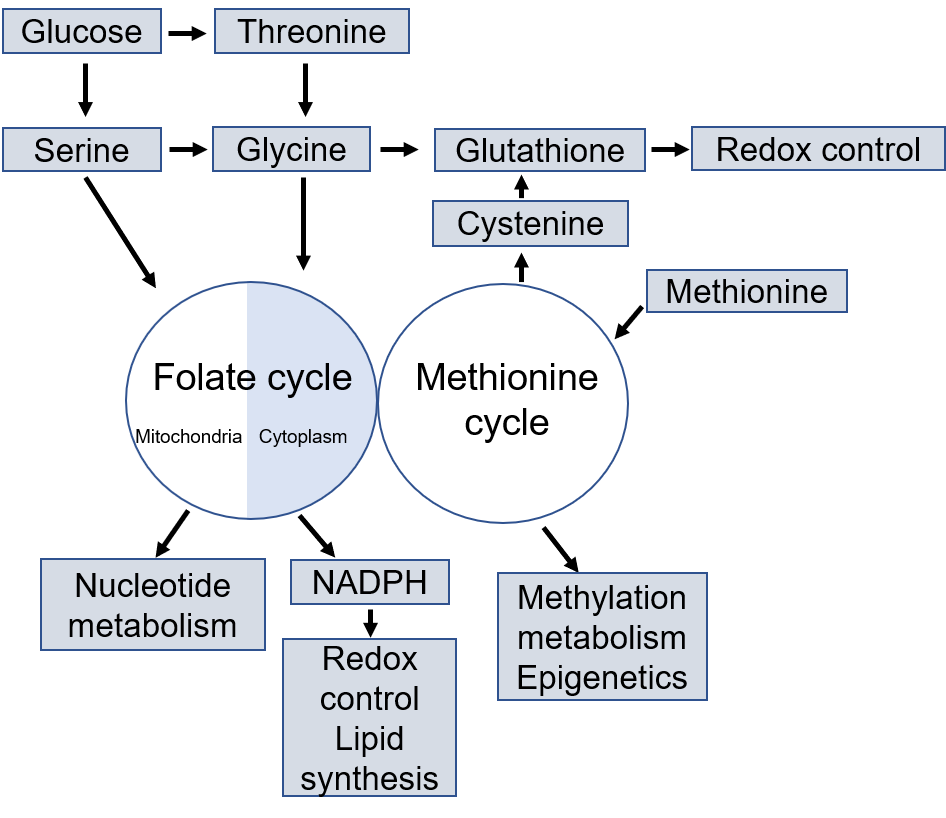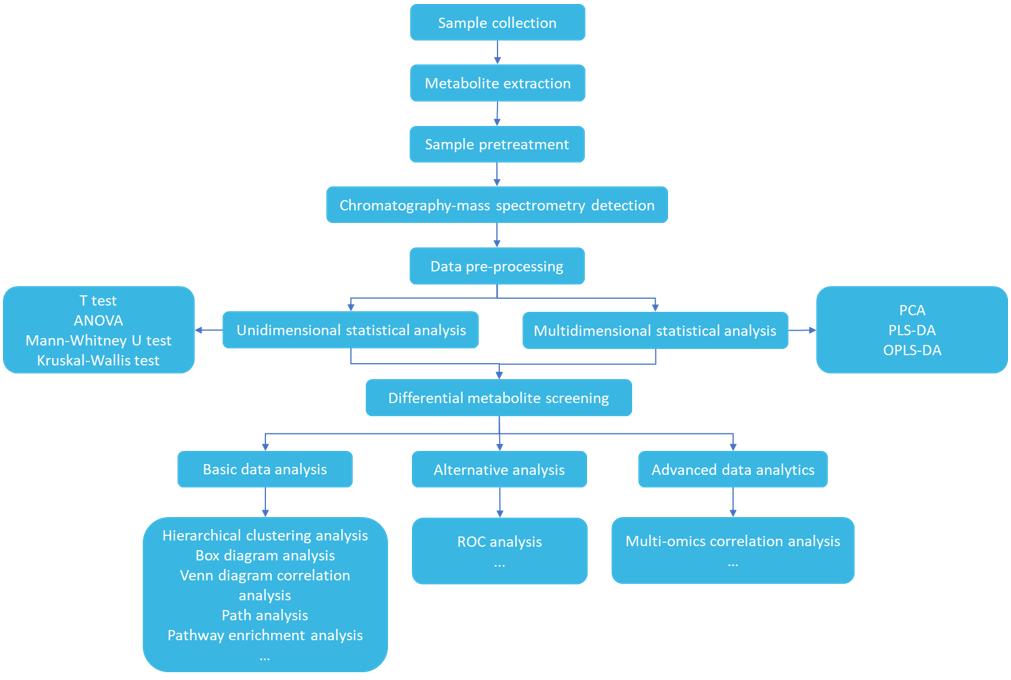Folate Cycle Metabolism Analysis Service
Submit Your InquiryWhat is the Folate Cycle?
As a member of enzyme cofactors, folate chemically activates one-carbon units for biosynthesis of formate, methanol and formaldehyde (Figure 1). One-carbon metabolism widely exists in the cytoplasm, mitochondria, and nucleus (Figure 1). They are the interdependent and indispensable biosynthetic pathways for polyamine synthesis and methylation reactions of a large variety of molecules such as neurotransmitters, phospholipids, proteins and numerous other small molecules. In the mitochondria, the one-carbon metabolism is also required for numerous reactions like the interconversion of glycine and serine, the metabolism of choline, purines and the synthesis of formylated methionyl-tRNA. Additionally, the one-carbon metabolism in the mitochondria provides most of the one-carbon units used for metabolism in cytoplasm. Altogether, folate molecules function as carriers for one-carbon units, allowing them to be manipulated and assembled in support of metabolic processes. Impairments in folate-mediated one-carbon metabolism are closely associated with various human diseases like Alzheimer and cancer.
Analysis of folate cycle metabolism can be achieved using liquid chromatography-mass spectrometry (LC-MS) methods, which allow the separation and detection of various components of the folate cycle to obtain accurate data on levels of folate cycle metabolites and their interactions with other metabolic pathways.
Creative Proteomics has an LC-MS technology platform for accurate and precise analysis of folate cycle metabolism. Our LC-MS method can identify and quantify various components of the folate cycle, including tetrahydrofolate (THF), 5-methyltetrahydrofolate (5-MTHF), and dihydrofolate (DHF).
 Figure 1. The overview of folate-mediated one carbon metabolism
Figure 1. The overview of folate-mediated one carbon metabolism
Applications of Folate Cycle Metabolism Analysis
- Folate status assessment: Folate is an essential nutrient that plays a critical role in a variety of physiological processes, including DNA synthesis and repair, neurotransmitter synthesis, and amino acid metabolism. Folic acid circulating metabolism analysis can help assess an individual's folate status, especially for pregnant women.
- Mechanistic studies and treatment development for genetic disorders: Some genetic disorders, such as methylenetetrahydrofolate reductase (MTHFR) deficiency, can affect folate metabolism and lead to various health problems. Analysis of circulating folate metabolism facilitates basic research and drug development.
- Cancer research: alterations in folate metabolism are associated with the development and progression of cancer. Analysis of folate circulating metabolism can provide valuable insights into the molecular mechanisms of tumorigenesis and identify potential targets for cancer therapy.
- Cardiovascular disease: Provides information related to the role of folate metabolism in the pathogenesis of cardiovascular disease.
- Pharmacokinetics: Folic acid is a key component of many drugs. Folic acid circulating metabolism analysis can provide pharmacokinetic information on these drugs and help optimize dosing regimens for maximum therapeutic benefit.
Folate Cycle Metabolism Analysis Platform by Creative Proteomics
Instrumentation
Agilent 1290 Infinity II High-Resolution Liquid Chromatography (HPLC) System: This HPLC system offers exceptional resolution, sensitivity, and versatility. With its binary pump, autosampler, and thermostatted column compartment, the Agilent 1290 Infinity II ensures precise separation and quantification of folate derivatives. The use of specific columns, such as the Agilent ZORBAX Eclipse Plus C18 column, further enhances chromatographic performance.
Thermo Fisher TSQ Altis Triple Quadrupole Mass Spectrometry (MS/MS) System: This mass spectrometer provides high sensitivity, specificity, and speed for the detection and quantification of folate metabolites. Equipped with hyperbolic quadrupole technology and intelligent Selected Reaction Monitoring (iSRM), the TSQ Altis offers exceptional sensitivity and selectivity. The use of specific ionization sources, such as electrospray ionization (ESI) or atmospheric pressure chemical ionization (APCI), allows for efficient ionization of folate derivatives.
Data Analysis and Interpretation
Data pre-processing: Pre-processing of raw data generated in LC-MS analysis involves data filtering, noise reduction, baseline correction and peak alignment to ensure high data quality.
Metabolite identification: Spectral matching algorithms and a database of known metabolites are used to identify and annotate detected peaks, confidently assigning metabolite identity based on retention time and mass spectra.
Quantification and Integration: A powerful quantification algorithm is used to determine the concentration of various folate derivatives in the sample. It integrates peak areas to calculate the precise levels of each metabolite, providing a review of the relative abundance and dynamics of folic acid metabolites in different biological samples.
Statistical analysis: Includes advanced statistical analysis tools to determine significant differences between sample groups. Statistical tests, such as t-tests, ANOVA or non-parametric tests, can be used to assess the significance of observed changes in folate metabolite levels. This allows you to identify potential biomarkers or investigate the effect of experimental conditions on the folate cycle.
Pathway analysis: Mapping detected metabolites to metabolic pathways and identifying enriched pathways or functional modules helps to understand the interconnection of the folate cycle with other metabolic pathways.
Data Visualization: Generate visualizations of data such as heat maps, scatter plots and pathway maps to facilitate data interpretation.
 Figure 2. The overall workflow of one carbon pool by folate
Figure 2. The overall workflow of one carbon pool by folate
List of Partial Detectable Folate Cycle Metabolites at Creative Proteomics
| Folic acid | Tetrahydrofolate | 5-Formiminotetrahydrofolate |
| Folinic acid | 10-Formyltetrahydrofolate | 5,10-Methylenetetrahydrofolate |
| Dihydrofolate | 5,10-Methenyltetrahydrofolate | 5-Methyltetrahydrofolate |
Sample Requirements
We can analyze a wide range of biological materials including but not limited to cells and solid tissues from animals. If you need transport your samples to us, please follow the following requirements for different types of sample:
- Blood/plasma: 500ul/sample
- Urine: 1ml/sample
- Tissue: 200mg/sample
- Cells: 1x107/sample
- Feces: 500mg/sample
Shipment condition: dry ice
References
- Ducker Gregory S, Rabinowitz Joshua D. One-Carbon Metabolism in Health and Disease.Cell Metab. 2017.25:27-42.
- Newman Alice C, Maddocks Oliver D K. One-carbon metabolism in cancer. Br J Cancer. 2017. 116:1499-1504.







